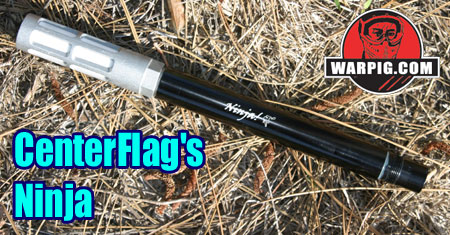  |
|
|
|
|
|
|
  |
|
|
|
|
|
|

What
do you think?
|

CenterFlag Ninja By Bill Mills, March 2004 If you’ve ever spent time at a paintball trade show – especially near a booth where techs are adjusting paintguns, or a new paintgun is being demonstrated you can understand why some people would want to make a dry-fired paintgun quieter. The same holds true for techs working on a paintgun inside a paintball shop where a salesperson is trying to hold a conversation with a customer.
In addition to the Autococker threaded Ninja, breech adapters are available which allow it to be used with Angel, AutoMag, Bushmaster, Impulse, Spyder, Tippmann 98 or Tippmann A-5 threaded paintguns.
The only paintguns which showed any noticeable tuning problems were the Matrices. Likely due to pressure build up created by air taking longer to escape from the barrel, a properly tuned LCD Bolt equipped Matrix would double fire when used with the Ninja. Similarly, blowback of gas through the feedneck of any marker is likely to be increased, because the air can not escape as easily through the muffler as through an open barrel. Timing Autocockers, and adjusting the Level 10 and ULE trigger components on an Automag proved to be a much less annoyingly loud task when performed with the Ninja.
It might be tempting to think that the sound reduction was only 21%. However, the decibel scale doesn’t work that way. The weakest sound audible to the human ear (near total silence) is zero decibels. A sound 10 times stronger is 10 dB, while a sound 100 times stronger is 20 dB, and 1,000 times stronger is 30 dB. Each step of 10 decibels represents an order of magnitude in sound increase. Normal conversation is around 60 dB, while extended exposure to sounds over 100 dB can cause hearing damage. For more on the levels of sound needed to cause damage, see this link.
There is more to the story however, than just the raw data. The type of sound produced was also altered. In addition to the drop in volume, the sound was not as sharp, sounding more like a lower pitched, dulled thud than a sharp crack. While this is a subjective observation, it was a much less annoying sound than the noise of dry firing through the barrel. Even with the Ninja in place the J2 was still louder than normal conversation levels, but not nearly as disruptive as dry firing through the stock barrel. CenterFlag’s Ninja mufflers are available
as a special order item through paintball dealers, or direct from CenterFlag
Products.
|
| Copyright © 1992-2019
Corinthian Media Services. WARPIG's webmasters can be reached through our feedback form. All articles and images are copyrighted and may not be redistributed without the written permission of their original creators and Corinthian Media Services. The WARPIG paintball page is a collection of information and pointers to sources from around the internet and other locations. As such, Corinthian Media Services makes no claims to the trustworthiness or reliability of said information. The information contained in, and referenced by WARPIG, should not be used as a substitute for safety information from trained professionals in the paintball industry. |